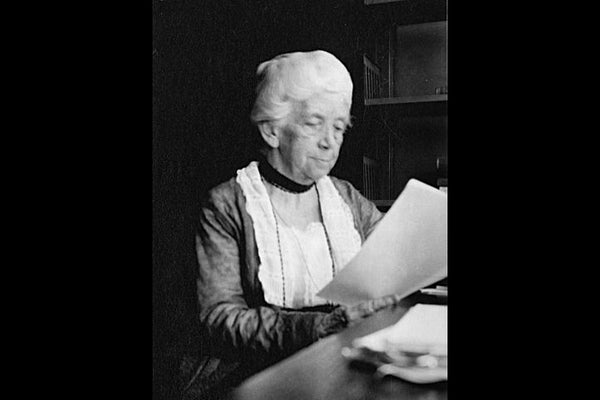This article was published in Scientific American’s former blog network and reflects the views of the author, not necessarily those of Scientific American
In 1926, Johns Hopkins University awarded a PhD for work in mathematics and logic to Christine Ladd-Franklin, a 78-year-old woman who had been working primarily in psychology for decades and was known for her women’s rights activism and theory of color vision. But 44 years prior, she had published her doctoral thesis, “The Algebra of Logic,” becoming the first American woman to complete the requirements for a PhD in mathematics…almost. Johns Hopkins had one degree requirement that Ladd-Franklin had failed to satisfy: be a man.
Ladd-Franklin grew up surrounded by brilliant women: her mother and three aunts. Her mother, Augusta Niles Ladd, and one of those aunts, Juliet Niles, took Christine to lectures about women’s rights when she was young. Steeped in their beliefs that women belonged in the same places men did with the same rights, it is no wonder that Ladd-Franklin saw herself as capable of and deserving access to higher education.
Her mother died when Ladd-Franklin was 12, and her paternal grandmother, with whom she lived following her mother’s death, did not want her to go to college because she would be too old to get married after graduating. Ladd-Franklin countered with the argument that there were too many young women in New England for such an unattractive one as her to land a husband. “Therefore since I could not find a husband to support me,” she wrote in her diary about the discussion, “I must support myself and to do so I needed an education. Grandma succumbed.” She went to Vassar for a year before withdrawing due to finances. With money she earned from teaching in upstate New York and assistance from her aunt Juliet, she was able to re-enroll. She graduated in 1869.
On supporting science journalism
If you're enjoying this article, consider supporting our award-winning journalism by subscribing. By purchasing a subscription you are helping to ensure the future of impactful stories about the discoveries and ideas shaping our world today.
Ladd-Franklin did not show exceptional interest or aptitude for mathematics early in her education. She was a Renaissance woman, studying several languages, music, botany, astronomy, and chemistry, in addition to mathematics. Her interest in mathematics and logic developed after graduation. While teaching science and mathematics in Washington, Pennsylvania, she started studying privately with mathematician George B. Vose, a professor at a local college, and wrote several articles for mathematics publications.
Ladd-Franklin applied to the recently-opened Johns Hopkins in 1878 under the name C. Ladd. (She would not marry Johns Hopkins mathematician Fabian Franklin until 1882.) Her application was retroactively rejected after the trustees learned that she was a woman. Johns Hopkins did not officially admit women, but cantankerous mathematician James Joseph Sylvester, who was familiar with Ladd-Franklin’s work and had encouraged her to apply, convinced them to admit her, sort of. Ladd-Franklin could attend Sylvester’s lectures, but her name did not initially appear on the school’s official rolls.
The first president of Johns Hopkins, Daniel Coit Gilman, was opposed to coeducation—for the protection of women from the “rougher influences” of men, of course—but from the beginning, the issue was contentious. Women, including the daughters of some trustees of the university, wanted to attend Hopkins, and the school’s policy was “marked by enough ambivalence and vacillation,” as historian of women at Hopkins Julia B. Morgan put it, that several women, including Ladd-Franklin, studied at Hopkins before the university admitted women generally.
Eventually, Ladd-Franklin started attending logician Charles Sanders Peirce’s courses as well. She became enthralled with logic and wrote a brilliant dissertation on symbolic logic, the practice of converting statements in logic into series of symbols that can be manipulated according to formal rules. In 1882, she finished her dissertation. She did not receive a degree from Johns Hopkins, but her undergraduate alma mater Vassar awarded her an honorary doctorate in 1887.
After leaving her studies at Johns Hopkins, Ladd-Franklin was not able to obtain an academic position in Baltimore. She continued research in areas that interested her—primarily vision and psychology—and eventually taught classes at Johns Hopkins and Columbia University, though without the benefit of an official faculty position or salary.
How did someone trained as a logician and mathematician end up studying color vision? Her first interest in the subject of vision seems to have been related to the geometry of binocular vision. When her husband had his sabbatical in the 1891-1892 academic year, she traveled to Germany with him, where she worked with George Elias Müller and Hermann von Helmholtz on research related to psychology and vision. Eventually, she developed a theory of color vision based on evolution: black and white was the most primitive form of color vision, with blue-yellow and red-green differentiation, respectively, coming later. Her theory has been superseded but was influential for many years.
I talked to Johns Hopkins archivist James Stimpert about the circumstances surrounding Ladd-Franklin’s finally obtaining a degree. The university first awarded a degree to a woman in 1893, and Stimpert says it is not clear why it took another 33 years to award Ladd-Franklin’s degree. Ladd-Franklin’s conferral happened during 50th anniversary celebrations for the university in February 1926, but Stimpert does not know of records of how exactly Ladd-Franklin’s degree was recognized. In a contemporary newspaper article, Anne Kinsolving reports that there was “loud applause” when her name was read and wondered, “Is Johns Hopkins University now conferring an honor upon Mrs. Christine Ladd-Franklin, or is Mrs. Christine Ladd-Franklin conferring an honor on Johns Hopkins University?” Ladd-Franklin died in 1930 a few years after finally receiving her degree.
If you want to know more about Ladd-Franklin, this article from the Vassar Encyclopedia is a great place to start and has links to several other resources.
